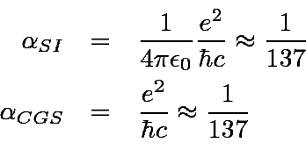- The fine structure constant has mystified scientists since the 1800s.
- The number 1/137 might hold the clues to the Grand Unified Theory.
- Relativity, electromagnetism and quantum mechanics are unified by the number.
The brilliant physicist Richard Feynman (1918-1988) famously thought so, saying there is a number that all theoretical physicists of worth should "worry about". He called it "one of the greatest damn mysteries of physics: a magic number that comes to us with no understanding by man".
That magic number, called the fine structure constant, is a fundamental constant, with a value which nearly equals 1/137. Or 1/137.03599913, to be precise. It is denoted by the Greek letter alpha - α.
What's special about alpha is that it's regarded as the best example of a pure number, one that doesn't need units. It actually combines three of nature's fundamental constants - the speed of light, the electric charge carried by one electron, and the Planck's constant, as explains physicist and astrobiologist Paul Davies to Cosmos magazine. Appearing at the intersection of such key areas of physics as relativity, electromagnetism and quantum mechanics is what gives 1/137 its allure.
Physicist Laurence Eaves, a professor at the University of Nottingham, thinks the number 137 would be the one you'd signal to the aliens to indicate that we have some measure of mastery over our planet and understand quantum mechanics. The aliens would know the number as well, especially if they developed advanced sciences.
The number preoccupied other great physicists as well, including the Nobel Prize winning Wolfgang Pauli (1900-1958) who was obsessed with it his whole life.
"When I die my first question to the Devil will be: What is the meaning of the fine structure constant?" Pauli joked.Pauli also referred to the fine structure constant during his Nobel lecture on December 13th, 1946 in Stockholm, saying a theory was necessary that would determine the constant's value and "thus explain the atomistic structure of electricity, which is such an essential quality of all atomic sources of electric fields actually occurring in nature."
One use of this curious number is to measure the interaction of charged particles like electrons with electromagnetic fields. Alpha determines how fast an excited atom can emit a photon. It also affects the details of the light emitted by atoms. Scientists have been able to observe a pattern of shifts of light coming from atoms called "fine structure" (giving the constant its name). This "fine structure" has been seen in sunlight and the light coming from other stars.
The constant figures in other situations, making physicists wonder why. Why does nature insist on this number? It has appeared in various calculations in physics since the 1880s, spurring numerous attempts to come up with a Grand Unified Theory that would incorporate the constant since. So far no single explanation took hold. Recent research also introduced the possibility that the constant has actually increased over the last six billion years, even though slightly.
If you'd like to know the math behind fine structure constant more specifically, the way you arrive at alpha is by putting the 3 constants h,c, and e together in the equation --
As the units c, e, and h cancel each other out, the "pure" number of 137.03599913 is left behind. For historical reasons, says Professor Davies, the inverse of the equation is used 2πe2/hc = 1/137.03599913. If you're wondering what is the precise value of that fraction - it's 0.007297351.





The formula is too complicated to be the key for the universe. -- And still it gives jus an approximation.
The idea of Unifies Theory is much simpler and right in front of our eyes. It is just not the time we "are allowed" to see it.